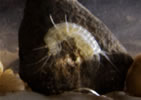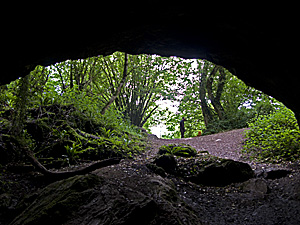As you move from outside the cave entrance into the cave threshold there is a change in the nature of plant life. This corresponds to changes in the habitats. There is a decrease in the amount of light and the increased shelter reduces wind and helps to maintain humidity (combined with the damp air in the cave). The proximity of an entrance means it will remain cool but relatively frost free.
FLOWERING PLANTS
Shade loving plants (sciophytes) will grow around the entrances of caves. There are three species of flowering plant commonly found in cave entrances that can cope with light levels down to 24 lux – Herb Robert (Geranium robertianum), Wood Sorrel (Oxalis acetosella) and Opposite Leaved Saxifrage (Chrysosplenium oppositifolium). (There are different methods of measuring light. Lux is one - a living room may be 60 lux, an office 400 lux and sunlight may produce 50,000 lux).
Other typical flowering plants of the threshold include Ivy (Hedera helix), Cuckoo Pint or Lords and Ladies (Arum maculatum), Stinging nettle (Urtica dioica), Dog Violet (Viola riviniana) and Dog’s Mercury (Mercurialis perennis) which prefers drier conditions.
In deep shade some plants have a different form with larger leaves e.g. Dog Violet, the mosses Eucladdium vertillatum, Adoxa and Phyllitis spp.and the Asplenium ferns.
Plants have a chemical (bit like chlorophyll) that switches its formula depending on light intensity. If light is low it exists in a form that prompts the plant to grow taller in an effort to reach more light (this is why seedlings in caves are often tall and spindly with a token leaf at the top).
Limestone soils are generally dry, well aerated and warm; waterlogging is not a problem. The soil and organic matter around entrances can produce locally acid conditions, this allows the growth of plants not normally associated with basic limestone soils e.g. Wood Sorrel.
FERNS
Fossils of ferns date back to 400 million years ago, about 300 million years before the first flowering plants appeared. Some ferns can grow in deep shade with light intensities down to 18 to 10 lux; one species, Rusty-Back Fern (Ceterach officinarum), can cope down to 5 lux. Both mosses and ferns are most abundant in damp shady areas due to the need for water for the male gametes and to complete their reproductive cycle (Flowering plants have evolved to overcome this problem).
Soft Shield fern (Polystichum setiferum) is common around cave entrances and can be found on slopes near caves.
Nearer the entrances and growing on the walls you may see Harts Tongue Fern (Phyllitis scolopendrium) and Maidenhair Spleenwort (Asplenium tichomanes). The latter is also sometimes found near show cave lights. Wall Rue (Asplenium ruta-muraria) prefers brighter conditions like those found on a cliff top.
The Male Fern (Dryopteris filix-mas) prefers neutral conditions and can be found around cave entrances. The Male Fern dies back each winter.
The British Polypody species are similar and also hybridise making identification difficult. The scarcest is Southern Polypody (Polypodium australe) which grows in limestone areas of south and west Britain. The Common Polypody (Polypodium vulgare) prefers acidic conditions throughout Britain, and the Western Polypody (Polypodium interjectum) prefers weakly acid or basic rocks and soils in western Britain. Spectacular colonies of P. australe can be seen on limestone walls and cliffs around cave entrances at Chudleigh, Torbryan, Pridhamsleigh, and in Higher Kiln Quarry at Buckfastleigh. The other Polypody species are often found growing as epiphytes on tree trunks.
Some species prefer more acidic conditions than can occur around cave entrances. The Mountain or Lemon-scented Fern (Oreopteris limbosperma) prefers acid conditions but can be found on limestone in moist, peaty woodland soils or where the lime has been leached from the soil. Hard Fern (Blechnum spicant) may be found on steep, damp, humus rich pockets, for example where water running down from more acidic conditions higher up causes leaching and results in conditions too acidic for the Shield Ferns or the Harts Tongue Fern. Due to their habitat requirements both these species are more likely to be found around mine entrances on Dartmoor. Lady Fern (Athyrium filix-femina) is another good indicator of more acidic conditions.
Other ferns include Broad Buckler Fern (Dryopteris dilatata), Bracken (Pteridium aquilinum), Wilson’s Filmy Fern (Hymenophyllum wilsonii) and the rare Tunbridge Filmy fern (H. tunbrigense). Both of the latter species prefer acid rocks and tree trunks in humid, sheltered conditions, and can sometimes be found in the entrances of small rift and boulder caves in granite on Dartmoor.
MOSSES
Mosses and liverworts are Bryophytes - simple green plants that have the ability to suspend their metabolism when desiccated (unlike a flowering plant that shrivels up and dies). Because they have no roots most of them absorb water, nutrients and gases over their whole surface. Like lichens they can be used as indicators of air and water pollution.
Closer to the entrance the shade increases and the ferns are replaced by mosses and liverworts - mosses are commonest at 10 lux, liverworts at 10 to 5 lux. As the light decreases only green algae and blue green algae (cyanobacteria) are found.
Typical mosses in the more shaded parts of limestone (i.e. in the gulleys on rock faces) are the yellow-green Ctenidium molluscum with its curved leaves, Fissidens adianthoides and Neckera crispa.
Eurhynchium sp. is very common in Devon growing abundantly on boulders and walls around entrances. It is tolerant of low light and can survive by show cave lights.
Some mosses form dense cushions e.g. Eucladium verticillatum; this one along with Cratoneuron filicinum (a golden green pinnate) prefers wetter habitats e.g. springs, where it forms the basis of the tufa dams. Eucladium and Palustriella commutata are tufa forming species, the mosses actively promoting the deposition of carbonate from seepage water. Tufa eventually hardens into a porous brown limestone called travertine. Palustriella commutata is rare in Devon as is tufa, which is normally limited to the limestone rich areas elsewhere in the country such as South Wales and Yorkshire, where there is an abundance of limestone pavement and consequently many streams and springs are rich in lime that becomes deposited as tufa. The limestone outcrops of Devon are rather scattered and small in comparison and few of the watercourses in the county run over exposed limestone for any appreciable length. Many of the main rivers in the county rise on Dartmoor and thus tend to have rather acidic water.
Orthotrichum anomalum grows on base-rich rocks (such as limestone) and artificial walls, buttresses etc., usually in exposed situations. It forms neat dark-green cushions.
Plagiomnium undulatum is common on rock walls by damp entrances. The Luminous moss (Schistostega pennata) is found on deeply shaded rocks around cave entrances and mine shafts. It is frequent in Cornwall but is rather rare in Devon and elsewhere although it occurs in a few Dartmoor mines. It is named due to the light refractive properties of some of the leaf cells, which give the moss a luminescent appearance when growing in dark places such as cave entrances.
LIVERWORTS
Liverworts are not quite as desiccation tolerant as mosses and so prefer moister habitats. The liverwort Conocephalum conicum is very common in cave entrances and becomes more stunted the further into the cave it grows.
Another common liverwort of cave entrances is Pellia endiviifolia. Other liverworts found in limestone gulleys include Scapania aspera, Targionia hypophyllaand Marchantia polymorpha.
ALGAE
This can be seen growing on the walls and roof inside cave entrances where it faces the outside. The green colour is quite clear on parts of the roof and walls inside the large entrances of Reed’s Cave and Pridhamsleigh Cavern.
On the nutrient deficient surface of limestone rock faces a thin grey/black film of cyanophilic algae may be present - these can fix their own nitrogen from the air.
The orange patches seen on limestone are actually a green algae called Trentepohlia. It contains carotenoid pigments that mask the green chlorophyll. It sometimes combines with certain fungi to form a lichen.
LICHEN
Lichens are usually associations between fungi and photosynthetic partners. The definition of a lichen is constantly changing as scientists discover new associations. Many 'species' live on limestone, and their hypae may actually extend into it. Those on limestone are often small and difficult to identify - as a result they have been neglected by biologists and there is scope for new discoveries in this area. They are able to survive extremes of conditions and can be found on the limestone pavements of Wales, Yorkshire and Derbyshire, on exposed clints and in the damp shaded depths of the grykes.
On steep dryish limestone walls you often see a whitish crusty looking lichen - this is a species of Lepraria.
|
Entrance to Pridhamsleigh |
|


